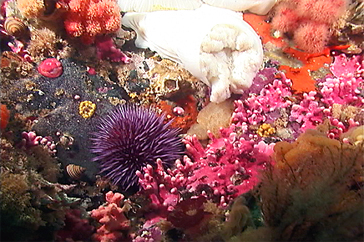Deep-sea Corals

NOAA, through its Fisheries, Ocean, and Research offices has recently ramped up a major program on deep-sea coral research. This research has a foundation spanning more than a century ago with the author Jules Verne who described an underwater forest "composed of large treelike plants....with branches of a shape I have never seen before" in his book 20,000 Leagues Under the Sea. For at least 200 years people who have fished have reported lines becoming entangled in deep-sea trees. These so called trees are thickets of corals that provide essential fish habitat for fish and other marine life. Unlike the shallow tropical coral reefs these corals are found in dark frigid waters often beyond the continental shelf break in many of the world's oceans.
Why are deep-sea corals important?
Only in the past two decades has there been an increase in the concern and study of these corals because their importance was not generally recognized nationally and internationally. These deep-sea trees of the seas can be thousands of years old and have been found at depths ranging from 150 to 3,000 feet although some species range to 20,000 feet. These corals, unlike the shallow water species, do not require symbiotic organisms and sunlight to provide their energy needs. In contrast, these deep-sea corals actively feed upon materials and nutrients in the water column. Deep-sea corals basically come in two types-hard or stony corals-which are similar to those found on tropical coral reefs and soft corals, which can be small and delicate or very large (up to 9 feet) and tree-like. Specifically, deep-sea corals are important for several reasons:
Deep-sea corals have a critical ecological role in that much like ancient forests they serve as habitat for a diversity of other organisms including fish and invertebrate communities, including commercially important fisheries species.
Future Actions
NOAA should build on recent deep-sea coral meetings and workshops held over the past year. These have included the Deep-Sea Corals Collaboration Planning Meeting (11-2003 Tampa, FL), the Deep-Sea Corals Workshop (1-2003 Galway, Ireland), and the 2nd International Symposium on Deep-Sea Corals (9-2003 Erlangen, Germany).
Critical information needs and research themes have emerged from these sessions:
Locating and mapping these corals, with a priority on U.S. deep-sea coral habitats, which have been largely unmapped when compared to European and Canadian coral habitats.
A more comprehensive understanding of the biology and ecology of deep-sea corals by conducting a species inventory, growth and reproductive studies, and food web and species interaction studies.
Understanding the uses of specific deep-sea species of corals as indicators of climatic change.
Exploration and research of deep-sea corals are key to increasing our understanding and improving the effective management of these unique organisms. These studies should be multidisciplinary and utilize the unique technologies and capabilities available to the research community.
 Deep Sea Crabs
Deep Sea Crabs